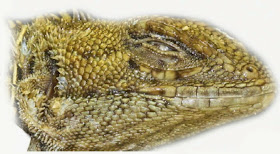Treerunners of the genus Plica
are Iguanid Lizards found in South America east of the Andes. They are medium
sized, conspicuous Lizards that are active in the daytime, living in small
colonies on rock outcrops or trees, and therefore are well represented in
museum collections, as they tend to attract the attention of collectors. There
are four species currently recognized, though two of these are considered to be
both widespread and morphologically variable, making it likely that there are a
number of cryptic species (species that cannot easily be differentiated from
similar species by simple visual examination, but which are nevertheless
reproductively isolated) within the group.
In a paper published in the journal ZooKeys on 25 November 2013,
John Murphy of the Field Museum of Natural History in
Chicago and Michael Jowers of the Departamento de Etología y Conservación de laBiodiversidad at the Estación Biológica de Doñana describe four new species of
Treerunner, from populations previously described as Plica plica.
The first new species described is named Plica caribeana, in reference to its distribution, on the Caribbean
coast of Venezuela and the islands of Trinidad and Tobago. Plicac aribeana has a lower number of dorsal scale rows than Plica plica, 92-125 as opposed to
126-140, and was confirmed to be a separate species by genetic analysis. It is
mottled green and brown in colour, with distinctive black markings, females
tend to be slightly larger than the males. The species lives in colonies of
6-15 individuals in forests or forest edges, and is frequently observed on
trees, rock-faces, buildings and even in caves. The species is insectivorous,
feeding on Ants, Beetles, Spiders, Cicadas and other Arthropods, and itself
appears to be a favoured prey item of the Tropical Flat Snake Siphlophis compressus. Females lay clutches of two eggs.
Plica caribeana, from the Arima Valley of Trinidad. Murphy & Jowers (2014).
The second new species is named Plica kathleenae,
in honour of the herpetologist Kathleen Kelly of the Division of Amphibians and Reptiles at the Field Museum of Natural History. The species is described from
a single male specimen collected by Emmet Reid Blake near the headwaters of the
Itabu Creek in the Sierra Acarai Mountains of Guyana, close to the border with
Brazil, during the Sewell Avery British Guiana Expedition of 1938. The specimen
has 158 dorsal scale rows at mid body (considerably more than Plica plica) and is a dark brown colour
with dark and light spots; though this is its colouration preserved in alcohol,
and probably differes from the colouration of the living animal.
The head of Plica kathleenae
in dorsal view. Murphy & Jowers (2014).
The third new species described is named Plica medemi, in honour of Colombian herpetologist Fredrico Medem,
who collected the single known specimen of this species at Cerro de las Pinturas
in Colombia in 1957. This species is also described from a single male
specimen, with 145 dorsal scale rows at mid body. The specimen is green with
dark spots and an orange head; since it is preserved in alcohol it was most
likely more strikingly coloured in life.
The head of Plica medemi
in dorsal view. Murphy & Jowers (2014).
The final new species described is named Plica rayi, in honour of Ray Pawley the former Curator of Reptiles
at Brookfield Zoo, for his lifelong work with Reptiles and Amphibians. This
species has 182-202 dorsal scale rows at mid body (considerably more than any
other member of the group. The Lizards are a dark brown colour with black and
white markings, the males develop red or orange markings on their faces in the
breeding season. The species is known from colonies at two sites on the Orinoco
River, at Puerto Ayacucho in Venezuela and at Puerto Carreno in Colombia, and
has been seen at other sites along the river. The species is found in granitic
rainforests (i.e. rainforests standing on granite-derived soils), and favours
rocky areas. The breeding season is in May.
Plica rayi. A male in breeding coloration. Photographed at Tobogan de la Selva,
Puerto Ayacucho. Zelimir Cernelic in Murphy & Jowers (2014).
See also…
Tropical Rainforests in Australia are found in a 430 km lowland
strip between Townsville and Cooktown in Queensland, known as the ‘Wet
Tropics’, and in smaller patches on the mountainous Cape York...
Skinks of the genus Carliaare found in northeast Australia, New Guinea and the
Wallacea biogeographical province between Australia and...
The application of genetic studies to populations of widespread animals
and plants in recent years has revealed that many widespread ‘species’
are in fact made up of several different cryptic species, which...
Follow Sciency Thoughts on Facebook.







